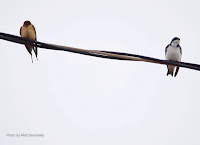TREE SWALLOW
TREE SWALLOW – (Tachycineta bicolor) – (See images below)
DESCRIPTION: The Tree Swallow is a small passerine bird. The male top parts are iridescent dark blue green, while the under parts are white. Females have similar colors but duller. The bill is small and black, and the mouth opens wide to allow catching insects on the fly. When folded, the wings are as long as the tail. The eyes are dark brown. The legs and feet are small and dark. This bird is around 12 cm (5 inches) long.
VOICE: https://www.xeno-canto.org/species/Tachycineta-bicolor
NAME: The English name ‘Swallow’ was given in reference to the feeding habits of this bird. It is called ‘Tree’ swallow because of its nesting habits. The Latin genus name ‘tachycineta’ means ‘moving quickly’, and the Latin species name ‘bicolor’ means ‘two colors’.
HABITAT: Open spaces or wooded areas, near water.
DIET: Mostly insects, caught on the fly.
NESTING: As their name implies, tree swallows nest in tree cavities, and will easily be attracted to nesting boxes. Between four and seven white eggs are laid, which are incubated by the female. Both parents feed the young. They are protective of their nest and will dive bomb on people or animals when the latter are getting too close.
DISTRIBUTION: Tree swallows breed in most of Canada (and Alaska) up to the tree line, and in the upper half of the USA. They migrate to the southern USA, Mexico and the Caribbean for the winter.
Distribution map: https://en.wikipedia.org/wiki/Tree_swallow#/media/File:Tree_Swallow-rangemap.gif
ON PEI: The tree swallow breeds on Prince Edward Island, and is very common in the spring and summer.
CONSERVATION: Tree swallows are widespread in North America and their population would reach some 16 million. In spite of some fluctuations in this number the species is not currently at risk.
NOTES: Tree swallows are very social in their wintering areas and may reach up to several thousand birds when roosting.
SIMILAR SPECIES: Cliff Swallow, Bank Swallow, Barn Swallow
REFERENCES: https://www.borealbirds.org/bird/tree-swallow
https://www.mba-aom.ca/jsp/toc.jsp (Maritimes Breeding Bird Atlas)
https://en.wikipedia.org/wiki/Tree_swallow
https://www.allaboutbirds.org/guide/Tree_Swallow/id
https://www.audubon.org/field-guide/bird/tree-swallow
http://www.nhptv.org/natureworks/treeswallow.htm (New Hampshire PBS)
https://www.ealt.ca/species-spotlight-list/tree-swallow (Edmonton and Area Land Trust)
DESCRIPTION: The Tree Swallow is a small passerine bird. The male top parts are iridescent dark blue green, while the under parts are white. Females have similar colors but duller. The bill is small and black, and the mouth opens wide to allow catching insects on the fly. When folded, the wings are as long as the tail. The eyes are dark brown. The legs and feet are small and dark. This bird is around 12 cm (5 inches) long.
VOICE: https://www.xeno-canto.org/species/Tachycineta-bicolor
NAME: The English name ‘Swallow’ was given in reference to the feeding habits of this bird. It is called ‘Tree’ swallow because of its nesting habits. The Latin genus name ‘tachycineta’ means ‘moving quickly’, and the Latin species name ‘bicolor’ means ‘two colors’.
HABITAT: Open spaces or wooded areas, near water.
DIET: Mostly insects, caught on the fly.
NESTING: As their name implies, tree swallows nest in tree cavities, and will easily be attracted to nesting boxes. Between four and seven white eggs are laid, which are incubated by the female. Both parents feed the young. They are protective of their nest and will dive bomb on people or animals when the latter are getting too close.
DISTRIBUTION: Tree swallows breed in most of Canada (and Alaska) up to the tree line, and in the upper half of the USA. They migrate to the southern USA, Mexico and the Caribbean for the winter.
Distribution map: https://en.wikipedia.org/wiki/Tree_swallow#/media/File:Tree_Swallow-rangemap.gif
ON PEI: The tree swallow breeds on Prince Edward Island, and is very common in the spring and summer.
CONSERVATION: Tree swallows are widespread in North America and their population would reach some 16 million. In spite of some fluctuations in this number the species is not currently at risk.
NOTES: Tree swallows are very social in their wintering areas and may reach up to several thousand birds when roosting.
SIMILAR SPECIES: Cliff Swallow, Bank Swallow, Barn Swallow
REFERENCES: https://www.borealbirds.org/bird/tree-swallow
https://www.mba-aom.ca/jsp/toc.jsp (Maritimes Breeding Bird Atlas)
https://en.wikipedia.org/wiki/Tree_swallow
https://www.allaboutbirds.org/guide/Tree_Swallow/id
https://www.audubon.org/field-guide/bird/tree-swallow
http://www.nhptv.org/natureworks/treeswallow.htm (New Hampshire PBS)
https://www.ealt.ca/species-spotlight-list/tree-swallow (Edmonton and Area Land Trust)
 |
| Tree swallow looking up, Matt Beardsley |
 |
| Tree swallow in flight, Matt Beardsley |
 |
| Tree swallow, PEI, by Sandra Meade |
 |
| Barn and Tree swallows, Matt Beardsley |
 |
| Tree swallow, PEINP, by Matt Beardsley |
 |
| Tree swallows, PEINP, by Matt Beardsley |
 |
| Tree swallow, North Lake, PEI, Lois Kilburn |